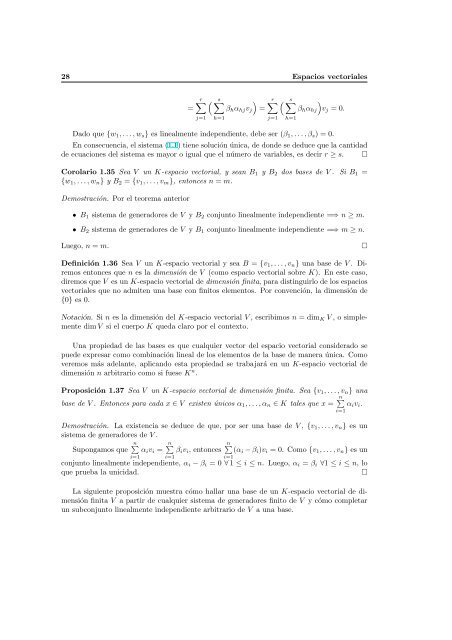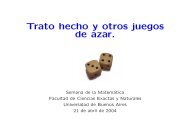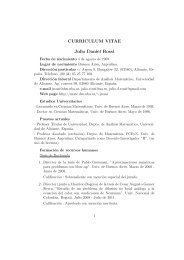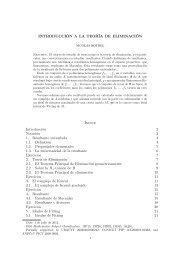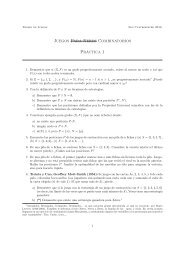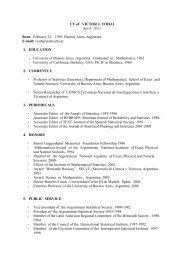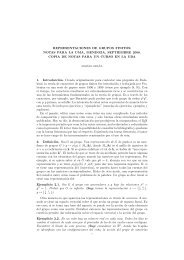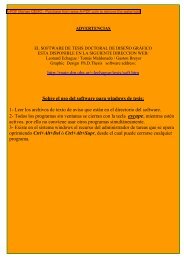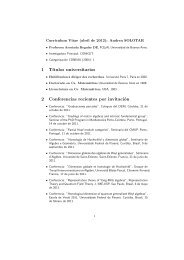´Algebra lineal - Universidad de Buenos Aires
´Algebra lineal - Universidad de Buenos Aires
´Algebra lineal - Universidad de Buenos Aires
Create successful ePaper yourself
Turn your PDF publications into a flip-book with our unique Google optimized e-Paper software.
28 Espacios vectoriales<br />
=<br />
r s<br />
j=1<br />
h=1<br />
βhαhjvj<br />
<br />
=<br />
r s<br />
j=1<br />
h=1<br />
βhαhj<br />
<br />
vj = 0.<br />
Dado que {w1, . . . , ws} es <strong>lineal</strong>mente in<strong>de</strong>pendiente, <strong>de</strong>be ser (β1, . . . , βs) = 0.<br />
En consecuencia, el sistema (1.1) tiene solución única, <strong>de</strong> don<strong>de</strong> se <strong>de</strong>duce que la cantidad<br />
<strong>de</strong> ecuaciones <strong>de</strong>l sistema es mayor o igual que el número <strong>de</strong> variables, es <strong>de</strong>cir r ≥ s. <br />
Corolario 1.35 Sea V un K-espacio vectorial, y sean B1 y B2 dos bases <strong>de</strong> V . Si B1 =<br />
{w1, . . . , wn} y B2 = {v1, . . . , vm}, entonces n = m.<br />
Demostración. Por el teorema anterior<br />
• B1 sistema <strong>de</strong> generadores <strong>de</strong> V y B2 conjunto <strong>lineal</strong>mente in<strong>de</strong>pendiente =⇒ n ≥ m.<br />
• B2 sistema <strong>de</strong> generadores <strong>de</strong> V y B1 conjunto <strong>lineal</strong>mente in<strong>de</strong>pendiente =⇒ m ≥ n.<br />
Luego, n = m. <br />
Definición 1.36 Sea V un K-espacio vectorial y sea B = {v1, . . . , vn} una base <strong>de</strong> V . Diremos<br />
entonces que n es la dimensión <strong>de</strong> V (como espacio vectorial sobre K). En este caso,<br />
diremos que V es un K-espacio vectorial <strong>de</strong> dimensión finita, para distinguirlo <strong>de</strong> los espacios<br />
vectoriales que no admiten una base con finitos elementos. Por convención, la dimensión <strong>de</strong><br />
{0} es 0.<br />
Notación. Si n es la dimensión <strong>de</strong>l K-espacio vectorial V , escribimos n = dimK V , o simplemente<br />
dim V si el cuerpo K queda claro por el contexto.<br />
Una propiedad <strong>de</strong> las bases es que cualquier vector <strong>de</strong>l espacio vectorial consi<strong>de</strong>rado se<br />
pue<strong>de</strong> expresar como combinación <strong>lineal</strong> <strong>de</strong> los elementos <strong>de</strong> la base <strong>de</strong> manera única. Como<br />
veremos más a<strong>de</strong>lante, aplicando esta propiedad se trabajará en un K-espacio vectorial <strong>de</strong><br />
dimensión n arbitrario como si fuese K n .<br />
Proposición 1.37 Sea V un K-espacio vectorial <strong>de</strong> dimensión finita. Sea {v1, . . . , vn} una<br />
base <strong>de</strong> V . Entonces para cada x ∈ V existen únicos α1, . . . , αn ∈ K tales que x = n<br />
αivi.<br />
Demostración. La existencia se <strong>de</strong>duce <strong>de</strong> que, por ser una base <strong>de</strong> V , {v1, . . . , vn} es un<br />
sistema <strong>de</strong> generadores <strong>de</strong> V .<br />
Supongamos que n<br />
αivi = n<br />
βivi, entonces n<br />
(αi − βi)vi = 0. Como {v1, . . . , vn} es un<br />
i=1<br />
i=1<br />
conjunto <strong>lineal</strong>mente in<strong>de</strong>pendiente, αi − βi = 0 ∀ 1 ≤ i ≤ n. Luego, αi = βi ∀1 ≤ i ≤ n, lo<br />
que prueba la unicidad. <br />
La siguiente proposición muestra cómo hallar una base <strong>de</strong> un K-espacio vectorial <strong>de</strong> dimensión<br />
finita V a partir <strong>de</strong> cualquier sistema <strong>de</strong> generadores finito <strong>de</strong> V y cómo completar<br />
un subconjunto <strong>lineal</strong>mente in<strong>de</strong>pendiente arbitrario <strong>de</strong> V a una base.<br />
i=1<br />
i=1


